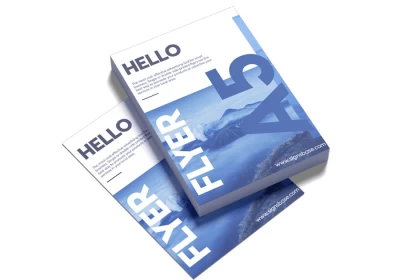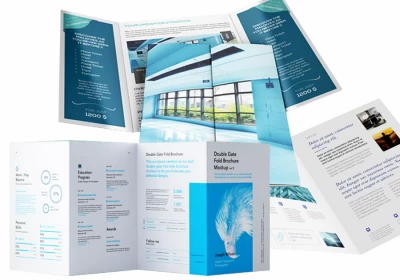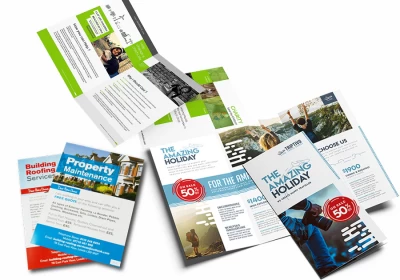Folds, Crease & Scoring
A good printer’s goal is to reproduce the work as close to the original as possible, no matter the quantity. When it comes to folding after printing, customers won’t tolerate a finished piece where sheets are warped, cracked, or split. Therefore, creasing and scoring becomes important for jobs when printed papers won’t fold without issue.
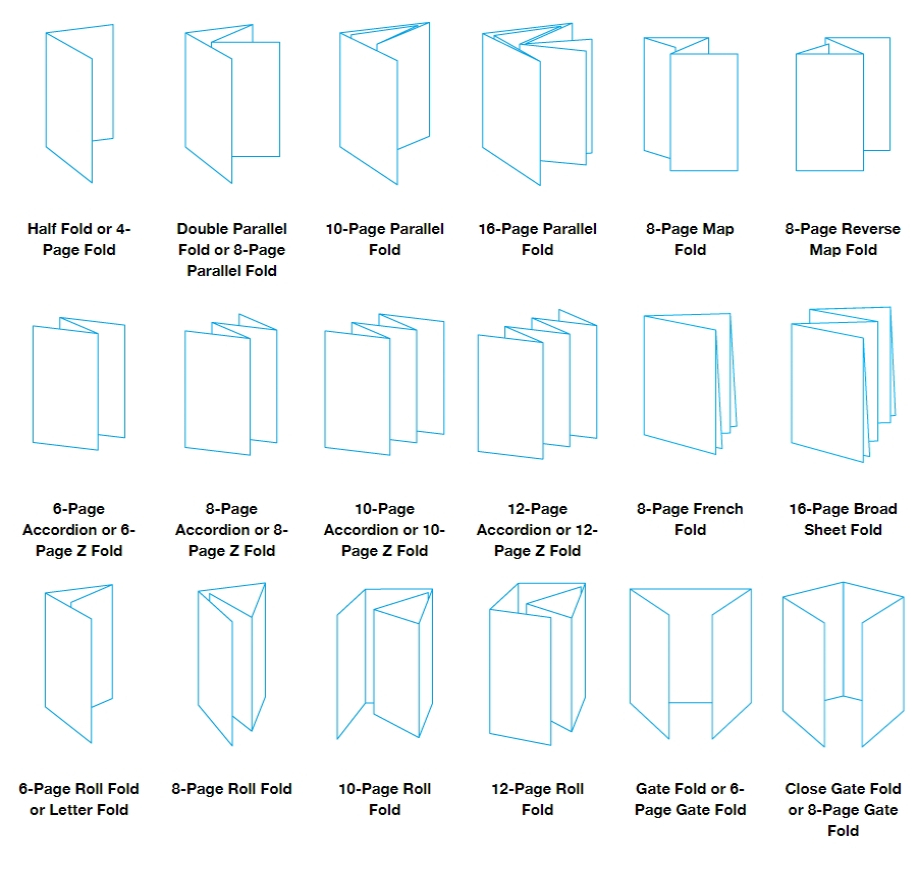
We’ve all designed a beautiful brochure with dark inks that wrap around from the front cover to the back cover and, up until it was folded, it was perfect and beautiful. Every time you fold paper, the paper can crack and this needs to be addressed in the design process. Planning is the best way to get ideal results. Here are some solutions to avoid cracking.
Always fold with the grain of the paper.
Paper fibers act like paper straws and this is called grain direction. Scoring the printed sheets should always be planned for all stocks that are .006 or thicker. It will not eliminate all cracking completely, but scoring will minimize the potential to crack. Thinner papers will crack more compared to thicker papers.
A thicker paper will allow for a more gradual fold and less cracking when scored. Varnishes, aqueous coating or UV coating will not stop the fold from cracking. The only way to totally eliminate cracking is to apply a film laminate to the surface. The laminate encapsulates the surface of the paper and will not allow any cracking. Planning is the best way to get ideal results. Keep the grain direction parallel with the fold and never fold across grain.
If cracking is a great concern to your design, let’s say because you are using dark inks and full paper coverage, then check with your printer before specifying a paper and let him know that you are concerned. He will offer solutions based on experience to minimize cracking.
There are several different types of fold that can be produced mechanically. We differentiate between parallel folds and cross folds.

Some of the standard paper folds that we do every day include:

The second strategy for handling cracking problems in high-quality commercial printing is creasing. Even if three factors listed above are all perfect, creasing (or scoring) may still be necessary for some stock. It’s worth noting that creasing and scoring, although often used interchangeably, are actually different. Scoring involves any method that reduces paper stiffness along a line, whereas creasing refers to the creation of a “paperboard hinge” via compression along the line where folding will occur.
When sheets are bent at the crease, the force that would normally cause splits or cracks in the sheet are directed inwards instead. As the fold continues, a rounded bead is formed inside the fold to absorb all the force, keeping the folded piece smooth and unbroken. Creasing can be achieved through a platen method (flat sheet and die board) or a rotary method (paper runs through cylinders or wraps around cylinder). Although scoring can eliminate fiber cracks, as the sheets get heavier a stronger compression force is needed to prevent cracking. That’s where creasing comes in, and why it’s so important to the entire printing process. When done successfully, creasing helps printers achieve a faithful print reproduction.

A score is the term given to the process of cutting stock part way through to enable an easy fold. Another common term for this process is "top cutting".
Scoring is often used on thick card, allowing sharp folding for products such as case made boxes. Scoring is also used when folding stock "against the grain", to help create sharp, straight folds. The depth of a score is generally half the thickness of the material that is to be folded.
There are many methods used to achieve a good score, from running the back edge of a knife along a straight edge or ruler... right through to setting a knife height to the nearest 0.01 of a millimeter on a CNC style digital cutter.
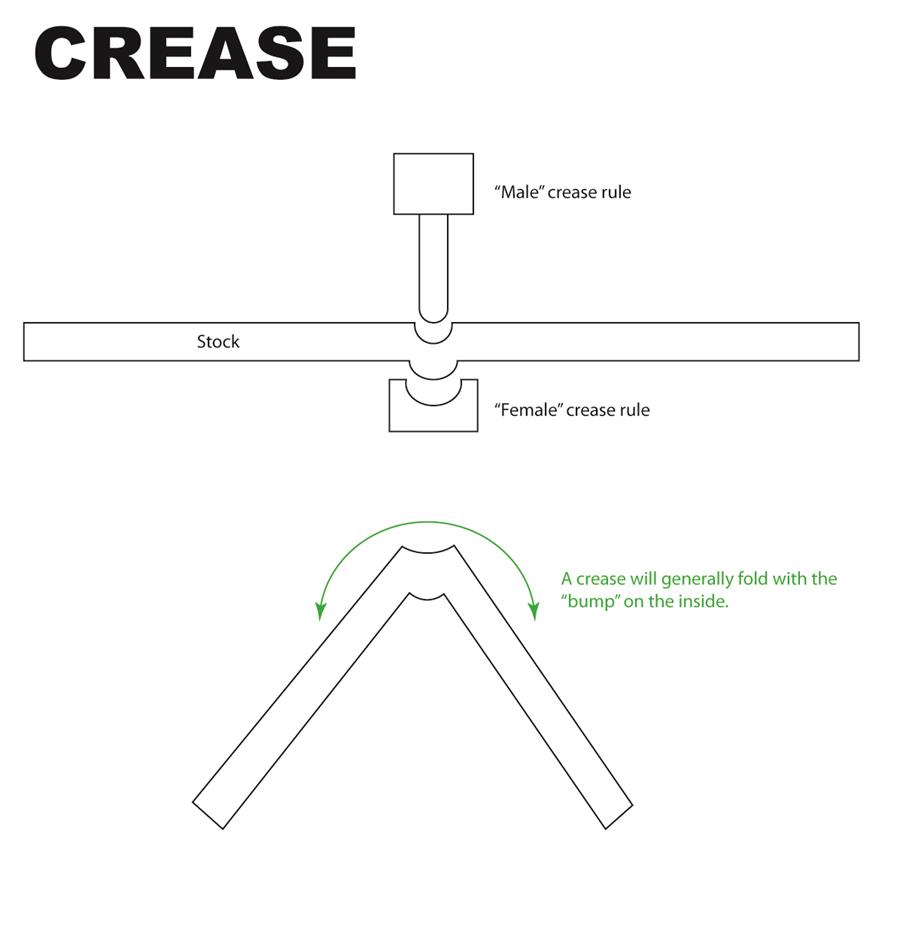
A crease is very different to scoring. Rather than actually "cutting" into the stock, creasing creates a "dent" along the entire length of a desired fold. In order to achieve a good crease, both a male and female "rule" are often needed. The stock is pressed between both to force it to the desired crease shape.
Creases can be done in multiple depths and widths but all have one thing in common, they do not cut into the stock! Rotary creasing is also a method used, the stock is passed through two rollers, the top roller containing a "male" creasing disc, and the bottom roller containing a "female" disc.
Another variation on creasing is the "heat crease" used for Polypropylene Where a heated creasing rule is pressed into the stock to "melt" a crease into the desired profile.

We’ve all designed a beautiful brochure with dark inks that wrap around from the front cover to the back cover and, up until it was folded, it was perfect and beautiful. Every time you fold paper, the paper can crack and this needs to be addressed in the design process. Planning is the best way to get ideal results. Here are some solutions to avoid cracking.
Always fold with the grain of the paper.
Paper fibers act like paper straws and this is called grain direction. Scoring the printed sheets should always be planned for all stocks that are .006 or thicker. It will not eliminate all cracking completely, but scoring will minimize the potential to crack. Thinner papers will crack more compared to thicker papers.
A thicker paper will allow for a more gradual fold and less cracking when scored. Varnishes, aqueous coating or UV coating will not stop the fold from cracking. The only way to totally eliminate cracking is to apply a film laminate to the surface. The laminate encapsulates the surface of the paper and will not allow any cracking. Planning is the best way to get ideal results. Keep the grain direction parallel with the fold and never fold across grain.
If cracking is a great concern to your design, let’s say because you are using dark inks and full paper coverage, then check with your printer before specifying a paper and let him know that you are concerned. He will offer solutions based on experience to minimize cracking.
Paper Folding Patterns for Commercial Printing
Folding a printed sheet in a regular sequence in order to give it the required shape for finishing.There are several different types of fold that can be produced mechanically. We differentiate between parallel folds and cross folds.

Some of the standard paper folds that we do every day include:
- Half fold
- Tri fold
- Gate fold - open
- Gate fold - closed
- Parallel fold
- Accordion fold
- Quarter fold
- Z Fold
Dealing with Folding Issues
It’s important to remember that there are a few factors that determine the performance of paper. The structure of paper varies with things like coating thickness and fiber content. Although coated papers tend to reproduce originals better, they are also more susceptible to cracking. The inks and varnishes involved in the printing process contribute to making paper less flexible. Paper’s moisture content and the relative humidity of your pressroom environment also play a role. As such, the first strategy for minimizing the cracking problem is to examine these three factors and make adjustments as needed.
Creasing & Scoring

The second strategy for handling cracking problems in high-quality commercial printing is creasing. Even if three factors listed above are all perfect, creasing (or scoring) may still be necessary for some stock. It’s worth noting that creasing and scoring, although often used interchangeably, are actually different. Scoring involves any method that reduces paper stiffness along a line, whereas creasing refers to the creation of a “paperboard hinge” via compression along the line where folding will occur.
Eliminating Cracking and Splitting
When sheets are bent at the crease, the force that would normally cause splits or cracks in the sheet are directed inwards instead. As the fold continues, a rounded bead is formed inside the fold to absorb all the force, keeping the folded piece smooth and unbroken. Creasing can be achieved through a platen method (flat sheet and die board) or a rotary method (paper runs through cylinders or wraps around cylinder). Although scoring can eliminate fiber cracks, as the sheets get heavier a stronger compression force is needed to prevent cracking. That’s where creasing comes in, and why it’s so important to the entire printing process. When done successfully, creasing helps printers achieve a faithful print reproduction.

A score is the term given to the process of cutting stock part way through to enable an easy fold. Another common term for this process is "top cutting".
Scoring is often used on thick card, allowing sharp folding for products such as case made boxes. Scoring is also used when folding stock "against the grain", to help create sharp, straight folds. The depth of a score is generally half the thickness of the material that is to be folded.
There are many methods used to achieve a good score, from running the back edge of a knife along a straight edge or ruler... right through to setting a knife height to the nearest 0.01 of a millimeter on a CNC style digital cutter.

A crease is very different to scoring. Rather than actually "cutting" into the stock, creasing creates a "dent" along the entire length of a desired fold. In order to achieve a good crease, both a male and female "rule" are often needed. The stock is pressed between both to force it to the desired crease shape.
Creases can be done in multiple depths and widths but all have one thing in common, they do not cut into the stock! Rotary creasing is also a method used, the stock is passed through two rollers, the top roller containing a "male" creasing disc, and the bottom roller containing a "female" disc.
Another variation on creasing is the "heat crease" used for Polypropylene Where a heated creasing rule is pressed into the stock to "melt" a crease into the desired profile.


